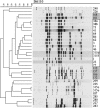Discovery of a novel Mycobacterium tuberculosis lineage that is a major cause of tuberculosis in Rio de Janeiro, Brazil
- PMID: 17898156
- PMCID: PMC2168543
- DOI: 10.1128/JCM.01394-07
Discovery of a novel Mycobacterium tuberculosis lineage that is a major cause of tuberculosis in Rio de Janeiro, Brazil
Abstract
The current study evaluated Mycobacterium tuberculosis isolates from Rio de Janeiro, Brazil, for genomic deletions. One locus in our panel of PCR targets failed to amplify in approximately 30% of strains. A single novel long sequence polymorphism (>26.3 kb) was characterized and designated RD(Rio). Homologous recombination between two similar protein-coding genes is proposed as the mechanism for deleting or modifying 10 genes, including two potentially immunogenic PPE proteins. The flanking regions of the RD(Rio) locus were identical in all strains bearing the deletion. Genetic testing by principal genetic group, spoligotyping, variable-number tandem repeats of mycobacterial interspersed repetitive units (MIRU-VNTR), and IS6110-based restriction fragment length polymorphism analysis cumulatively support the idea that RD(Rio) strains are derived from a common ancestor belonging solely to the Latin American-Mediterranean spoligotype family. The RD(Rio) lineage is therefore the predominant clade causing tuberculosis (TB) in Rio de Janeiro and, as indicated by genotypic clustering in MIRU-VNTR analysis, the most significant source of recent transmission. Limited retrospective reviews of bacteriological and patient records showed a lack of association with multidrug resistance or specific risk factors for TB. However, trends in the data did suggest that RD(Rio) strains may cause a form of TB with a distinct clinical presentation. Overall, the high prevalence of this genotype may be related to enhanced virulence, transmissibility, and/or specific adaptation to a Euro-Latin American host population. The identification of RD(Rio) strains outside of Brazil points to the ongoing intercontinental dissemination of this important genotype. Further studies are needed to determine the differential strain-specific features, pathobiology, and worldwide prevalence of RD(Rio) M. tuberculosis.
Figures





References
-
- Baptista, I. M., M. C. Oelemann, D. V. Opromolla, and P. N. Suffys. 2002. Drug resistance and genotypes of strains of Mycobacterium tuberculosis isolated from human immunodeficiency virus-infected and non-infected tuberculosis patients in Bauru, Sao Paulo, Brazil. Mem. Inst. Oswaldo Cruz 97:1147-1152. - PubMed
-
- Barczak, A. K., P. Domenech, H. I. Boshoff, M. B. Reed, C. Manca, G. Kaplan, and C. E. Barry III. 2005. In vivo phenotypic dominance in mouse mixed infections with Mycobacterium tuberculosis clinical isolates. J. Infect. Dis. 192:600-606. - PubMed
-
- Barnes, P. F., and M. D. Cave. 2003. Molecular epidemiology of tuberculosis. N. Engl. J. Med. 349:1149-1156. - PubMed
Publication types
MeSH terms
Substances
Grants and funding
LinkOut - more resources
Full Text Sources
Other Literature Sources
Medical
Molecular Biology Databases
Miscellaneous

